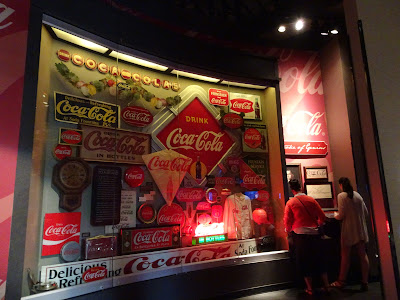We paid extra for
the VIP Tour and were very glad we did ($32 each, we weren’t old enough for the
senior discount).
Our VIP tickets got us in early so we were able to walk
past hundreds (it sounded like thousands) of school kids and get into the building
only to wait around for our tour to start.
We had the opportunity to drink a free sample while
awaiting our tour.
Mark picked Coke Zero.
I decided drinking a can of coke before a 2-hour tour might not be a
good idea.
There were many giant bottles of coke sitting around the
lobby. This one was carved out of wood.
This bottle is carved out of wood.
We had an “Ambassador” as our VIP tour guide who walked
us to the head of the line for the first part of our tour.
Our tour started with an introduction given by another Ambassador. This young man was hilarious! He had a very deep voice and ….. talked …..
very ….. slowly. He was great!
In his very - slow - voice he talked about the rare and
one-of-a-kind objects around the room.
From this room we went into a theater for a short
film. No movies or pictures were
allowed. The movie just showed people
having fun drinking coke with lots of very loud music.
After the movie our VIP Tour started.
We headed out to have our picture taken with the 7’ tall
polar bear.
The bear kept stepping on my foot!
We were given head-sets.
It would have been impossible to hear our guide without them.
Our first stop was to learn the history of Coca-Cola.
In 1886 Dr. John S. Pemberton created a flavored syrup
that was mixed with carbonated water.
John S. Pemberton
His bookkeeper, Frank Robinson, is credited with naming
the beverage Coca-Cola as well as designing the distinct script. He liked the catchy sound and thought 2 c’s
would look good in advertising. The
script is written in his own hand.
During the first year, sales averaged nine servings per
day in Atlanta. Today, daily servings of
Coca-Cola beverages are estimated at 1.9 billion globally.
In 1888, two years after creating Coca-Cola, Pemberton
sold the formula and rights to the business to Atlanta businessman, Asa G.
Candler for $2,300.
In 1899, Candler sold the bottling rights to Joseph
Whitehead and Benjamin Thomas for $1.
This is the original contract for the bottling rights.
In 1915 with lots of imitations of coke by competitors
the bottlers agreed that a distinctive bottle that could be recognized, even in
the dark, was needed. In 1916 the first
contoured Coca-Cola bottle was approved.
The contoured bottle of today was trademarked in 1977.
Chandler added the Coke logo to practical, everyday
objects. He also introduced the first
wide-spread use of sampling coupons which could be redeemed at soda fountains
for a free Coke. By 1920, 1 out of every
9 people in the US had sampled a free coke.
In 1919 the Chandler family sold the formula and rights
to a group of investors for 25 million.
Why 6 in a 6-pack?
Apparently, the average family consisted of Mom, Dad, 3
children, and a mother-in-law.
This dispensing machine was on the space shuttle.
Coke is big on sponsorships.
Olympic torches.
Football
Next time: We see
the bottling process, possibly the stickiest floor in the WORLD, and we finally
get to the Vault where the secret formula is guarded.





















An ideal tour for a couple of Coke heads. That Coca-Cola written name is a famous example of Spencerian script.
ReplyDeleteIt is very elegant! People today don’t even write complete words much less try to make them look pretty.
DeleteOne reason I drink diet sodas isn't because they have no calories, it is because if I spill them, it isn't sticky. I wonder how many tons of sugar they go through in a day of production.
ReplyDeleteWait till tomorrows post. I thought my shoes would be sucked off!
Delete